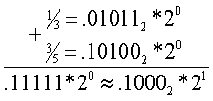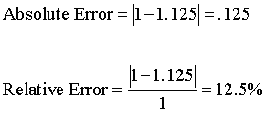|
[ Index ] |
|

|
[ Index ] |
|

Q: Why do we use binary
numbers?
A: We use binary numbers because it was easy to
implement with circuits. Binary only requires two states: "ON" and "OFF"
Example: 537.510 = 1 x 29 + 0 x 28 + 0 x 27 + 0 x 26 + 0 x 25 + 1 x 24 + 1 x 23 + 0 x 22 + 0 x 21 + 1 x 20 + 1 x 2-1
How to get from base 10 to base 2
Separate the integer part from the fraction part: N.F
The integer part can be represented as
![]()
We wish to find the digit bi (0 or 1)
We divide by 2:
![]()
The remainder determines if b0 is 0
- Repeat until the integer part is 0
Example: How to
convert 34 in base 10 to binary (base 2)
34/2 = 17 R 0 ==> 0
17/2 = 8 R 1 ==> 1
8/2 = 4 R 0 ==> 0
4/2 = 2 R 0 ==> 0
2/2 = 1 R 0 ==> 0
1/2 = 0 R 1 ==> 1
So 3410 = 1000102
Note : The binary representation is the reverse of the 1's and 0's obtained by
dividing
Example:
0.12 = 1*2-1 = 1/2
0.012 = 1*2-2 = 1/4
0.112 = 1*2-1 + 1*2-2
= 1/2 + 1/4
= 3/4
Q: What about 1/3?
A: 1/3 = .3333
= 1/2 * 0 + 1/4 * 1 + 1/8 * 0 + 1/16 * 1 + ... = 0.01010110
Representation of numbers in the machine
Two common representations:
1. Fixed Point
2. Floating Point
Fixed Point
The number of bits for the integer part and the fraction part are fixed
Example: NNNN.FF2 has 4 bits
for the integer part and 2 bits for the fraction
This is just an example: usually you would give more bits for for both the
integer part and the fraction.
For example: 2 bytes for the integer and 2 bytes for the fraction
Advantages of fixed point:
| Fast arithmetic - Uses integer arithmetic Example: 1.0 1 = 1.25 + 1 0.1 0 = 2.5 -------------------------- 1 1.1 1 = 3.75 | |
| Used in in signal processors and signal processing
programs that require real time operations Example: MP3 Player, MP3 Encoder/Decoder, MPEG, etc |
Disadvantages of fixed point:
| Very restrictive range | |
| Bad precision | |
| Smallest number is restricted to the number of bits used in the fraction | |
| Generates a lot intermediate of errors during operations |
Floating Point
The decimal point moves around to keep the
desired precision.
Uses scientific notation:
![]()
Q is called the mantissa
N is called the exponent
The precision of the number depends on the number of bits used to represent Q.
The numbers are represented in the computer as
![]()
where Q and N are represented by a fixed number of bits.
Uniqueness
To have a unique representation for each number,
numbers are normalized or adjusted so that
![]()
except for 0. The uniqueness is useful for some operations such as checking for
equality.
Example: Adding (1/3 + 3/5) + 1/15
Assume 4-bit mantissa and
2-bit exponent
1/3 = (.010101...)2 * 20 = (.10101...)2
*2-1 =>(.1011)2 *2-1
3/5 = (.1000110011...)2
* 20
=> (.1010)2 * 20
Adding 1/3+3/5
Normalize the largest exponent before addition
Note:
Result has the larger of the two exponents

Note: When processors add numbers, they use registers twice as big for
the computation.
Adding 1/15 to the previous result
1/15 =
(.100010001...)2
* 20 =>
(.1001)2 * 2-3

Since 1/3 + 3/5 + 1/15 = 1 and our result was 1.125, then there was an error due to the very small mantissa.

Modern architectures give 2 options to represent real numbers:
Single precision (float)
| |||||||||||
Double precision (double)
|
Webpage by Emil Stefanov